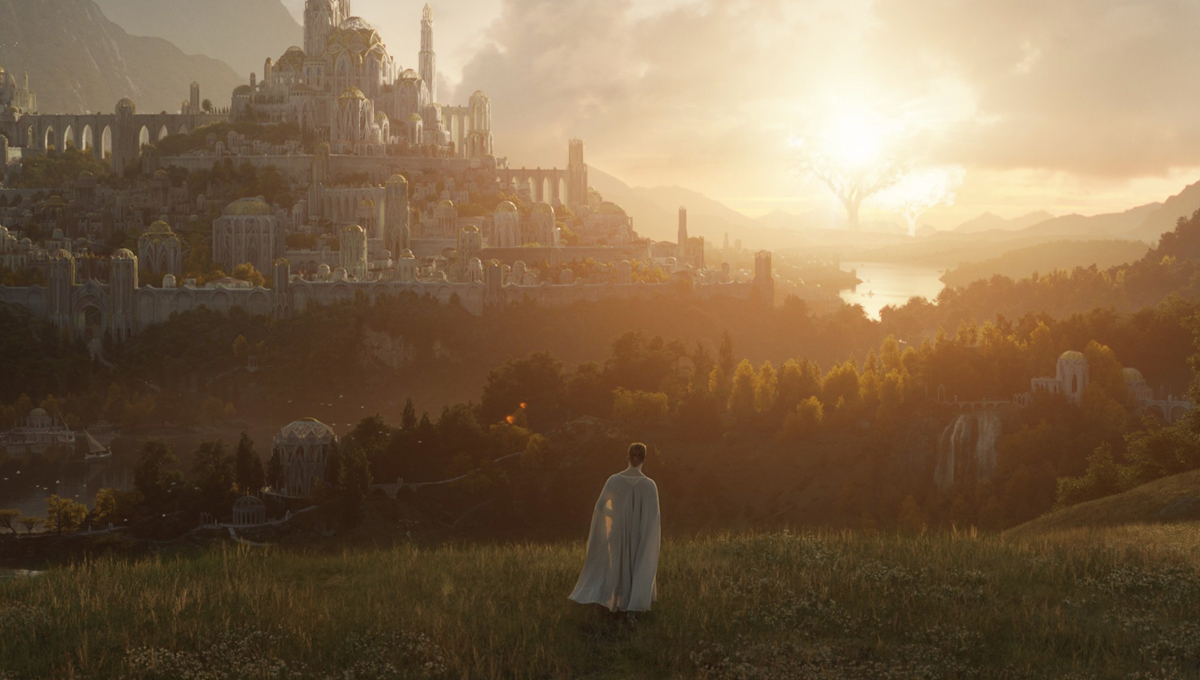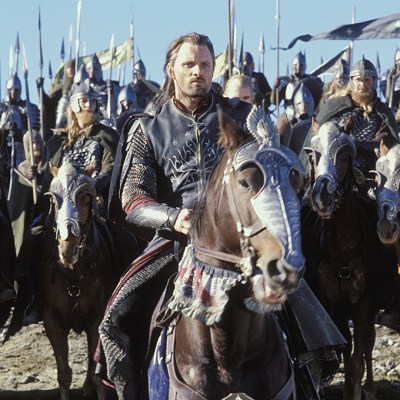The seemingly impenetrable veil of secrecy that has long covered Amazon’s The Lord of the Rings television series has been slightly lifted. Firstly, the series now has a firm release date to hype; one that, unfortunately for impatient fans, won’t arrive until Sept. 2, 2022 (yes, you read that correctly, 2022). However, sweet succor for that bittersweet revelation also arrived, since Amazon also released the very first official image from the series, giving everyone a long-desired visual hint as to what a purported overall budget of around $1 billion buys you. Sticker shock aside, the image is nevertheless impressive, and, while released without context, has been deduced as an awe-inspiring landscape look at the realm of Valinor!
While a proper title for the series remains withheld, Amazon’s debut image from The Lord of the Rings is a sight to behold as it immediately brings your focus to a mysterious foreground figure in a white cloak before your gaze is set loose onto the sublime imagery of a sprawling castle flanked by a majestic forest separated by a stream. While one might be inclined to think that we’re simply seeing an area of Middle Earth that’s new to fans of Peter Jackson’s The Lord of the Rings and The Hobbit movie trilogies, the light source in the far background that one might have initially mistaken for the sun is, in fact, the piercing illumination of two giant trees, the Two Trees of Valinor. Thusly, it appears that the frequently-referenced but never-seen locale of Valinor, a.k.a. the Undying Lands (the mystical place to which Frodo, Gandalf and Bilbo sailed off into the sunset for a special privilege retirement,) has finally manifested in live-action form.
Contextually, in J.R.R. Tolkien’s literary lore, the island of Valinor (Tolkien’s version of Avalon), is where the Valar (archangels of the mythos,) settled down after the music of deity Eru Ilúvatar broke an incalculable period of silence and shapelessness in existence to construct the universe. Tellingly, the mere presence of the trees—created by the Valar to light to planet of Arda—dates the era of the image, which can be deduced as taking place during the planet’s primordial period, since said trees would not be long for the burgeoning world. This could also mean that the mysterious cloaked figure—overlooking what appears to be primary city Valmar—is one of the Valar, perhaps Manwë, the oldest and most powerful of the Ainur (holy spirit beings).

Named Laurelin (a Gold Tree towards the South) and Telperion (a Silver Tree towards the North), the Two Trees of Valinor were the first sources of light in the universe. Their majesty would conjure jealousy in the bad seed Valar known as Melkor (later better known as Morgoth), who sought to destroy them by recruiting the help of the giant spider creature called Ungoliant, progenitor of Middle Earth’s monster spiders such as Shelob, who notably dwelt in Cirith Ungol. Thusly, the creature invaded the sacred island and consumed the duo of mystical trees, poisoning their remains; an act of ontological vandalism that left their last flowers—which shone gold and silver—to be used as the sun and the moon, respectively. Additionally, the last vestiges of the two trees’ light were captured into the three jewels known as the Simarils, which would eventually become the titular MacGuffin for most of the First-Age-era stories told in Tolkien’s posthumous tome, The Silmarillion.
With all that said, you might be asking yourself how this backstory connects—at least, in an immediately pertinent manner—to the plot of Amazon’s The Lord of the Rings series, which has been confirmed to take place in Middle Earth’s Second Age, several thousands of years after the destruction of the Two Trees of Valinor. The likely answer is that the teaser image is taken from a prologue, a practice in exposition famously exercised in powerfully pithy manner in Jackson’s Rings Trilogy, and to a certain extent, in The Hobbit as well. This one, however, would set into context the show’s primary plot centered on the Fall of Númenor, a star-shaped island kingdom that once prominently sat as the maritime centerpiece of Middle Earth.
Read more
Inhabited by a race of Men blessed with long life, Númenor’s story is one highlighted by majestic glory at its height and hubris-bred destruction at its nadir. This came about due to the unbridled ambitions of King Ar-Pharazôn, who—due to the insidious influence of a captured Sauron—became resentful of Valinor’s ban of mortals, and sought to seize immortality itself with an attempt to invade the holy island with a fleet of ships. The effort, of course, failed spectacularly after a divine cataclysmic, planetary-scale retribution so powerful that it hid Valinor from the reach of the physical realm, and turned the world from flat to round, leaving Númenor sunk beneath the sea.
Of course, with very few narrative bones thrown our way, the story behind this Lord of the Rings teaser image will remain categorized as speculation. Nevertheless, despite the far-off release date, production on the series has moved past its primary obstacle after COVID cost it most of 2020. Indeed, cameras have been rolling for nearly a year now, having commenced since this past September. Notwithstanding occasional hiccups such as the exit of key consultants and this past March’s “studio decision” to nix series regular Tom Budge, things seem to be moving along smoothly in what has clearly been a trial by fire for showrunners J.D. Payne and Patrick McKay.
The Lord of the Rings (title to be revealed) will eventually arrive on Amazon Prime Video on Friday, Sept. 2, 2022.


